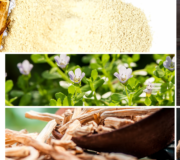Hawthorn is among the most important of medicinal plants and has been used since ancient times across continents and medical traditions for both its nutritional and medicinal properties. A number of Hawthorn species have been employed, with Crataegus monogyna and C. laevigata (synonym C. oxyacantha) being most prominent in Western herbal traditions. Botanically, Hawthorn is a deciduous tree of the Rose family that is native to Europe and is distributed widely throughout North America and western parts of Asia. Different parts of the plant including leaves, flowers, and berries have been documented for their medicinal effects and have a long traditional use for improving cardiac and circulatory function.1
The cardiotonic properties of Hawthorn were first recorded in Europe during the late 1800s, and the herb was later introduced to North American medical practice by the Eclectic Physicians during the 19th century.2 Traditionally, Hawthorn has been used for the treatment of conditions such as hypertension, hyperlipidemia, and as an anti-atherosclerotic, antispasmodic, and diuretic agent. One of the first mentions of Hawthorn in scientific research was for its beneficial effects against hypertension in 1939, and since then its cardiotonic efficacy has since been proven by numerous laboratory and clinical studies, particularly when standardized to its powerful polyphenol content.3
How Hawthorn Works
Hawthorn’s pharmacological effects and chemical constituents have been extensively investigated, and range from amines, terpenoids, and polyphenolics including chlorogenic acid, epicatechin, hyperoside, quercetin, rutin, vitexin, and procyanidins.4-6 In particular, Hawthorn has an outstanding content of polyphenols with powerful antioxidant properties including oligomeric procyanidins (OPCs) and flavonoid glycosides such as vitexin-2″- rhamnoside, which have been implicated as some of its most important secondary metabolites.7 The bioactivities of these polyphenols have revealed extracts with remarkably high levels of antioxidant activity, lending in large part toward their anti-atherogenic and cardioprotective effects.8-11 Moreover, a bark extract of Hawthorn was shown to have antioxidant effects through activation of nuclear factor like-2 (Nrf2) pathways, while increasing messenger ribonucleic acid (mRNA) and protein levels of several Nrf2-dependent genes in vitro.12
Hawthorn for Heart Health
The wide range of cardiovascular studies documented on Hawthorn point to its polyvalent bioactivity and cardioprotective effects, which have been largely associated with its rich polyphenolic content. Numerous experimental and clinical studies using Hawthorn standardized for its polyphenolic content have demonstrated efficacy for cardiovascular conditions ranging from angina, hypertension, myocardial insufficiency, mild arrythmias, and atherosclerosis through a variety of mechanisms including:13-15
- Positive inotropic (muscle contractility) and negative chronotropic (heart rate) effects
- Improving the strength of cardiac muscle contractions
- Increasing coronary blood flow and exercise tolerance
- Inhibition of enzymes such as angiotensin converting enzyme (ACE) and phosphodiesterase
- Anti-inflammatory and anti-hyperlipidemic effects
- Improving status of antioxidant enzymes
Chronic Heart Failure
A 2008 meta-analysis of randomized, double-blind, placebo-controlled trials, established the efficacy of standardized Hawthorn (leaf, berry, and/or flower) in the treatment of chronic heart failure when given over a range of three to six weeks. In most of the studies included, Hawthorn was used as an adjunct to conventional drug treatment, and stronger effects from Hawthorn were noted in those who had more severe baseline conditions. The analysis also found that Hawthorn demonstrated an excellent safety profile and that any adverse effects were infrequent, mild, and transient.16
Hawthorn extract has also demonstrated positive effects on endothelial dysfunction, in part by mediating endothelial calcium signaling and thus protecting against endothelial hyperpermeability, which is crucial in edema formation and inflammatory processes related to heart failure.17
Anti-atherogenic
Another aspect of Hawthorn’s cardioprotective properties is its influence on lowering blood cholesterol and potential role in preventing the progression of cardiovascular disease and, in particular, atherosclerosis. Several mechanisms of this action have been proposed, with Hawthorn berry tinctures shown to reduce total cholesterol as well as all cholesterol fractions (VLDL, LDL, HDL) by increasing cholesterol liver uptake and degradation and decreasing synthesis in animal models.18 Moreover, a double-blind trial using Hawthorn leaf and flower extract over six months found it significantly decreased plasma levels of neutrophil elastase (an important enzyme involved in the development and progression of atherosclerosis) in diabetics with chronic coronary heart disease when compared to placebo while also significantly lowering LDL cholesterol levels.19
In conclusion, the multitude of effects of Hawthorn demonstrated from both preclinical and clinical data have revealed a safe and efficacious cardioprotective plant that can improve cardiac performance in patients with mild to moderate heart failure, while also protecting against more general cardiovascular dysfunction. The presence of potent antioxidant polyphenolics in Hawthorn appears to be primarily responsible for mitigating the harm within the cardiovascular system, helps to alleviate the disease burden of patients with cardiac complaints, and ultimately leads to meaningful improvements in their quality of life.


















